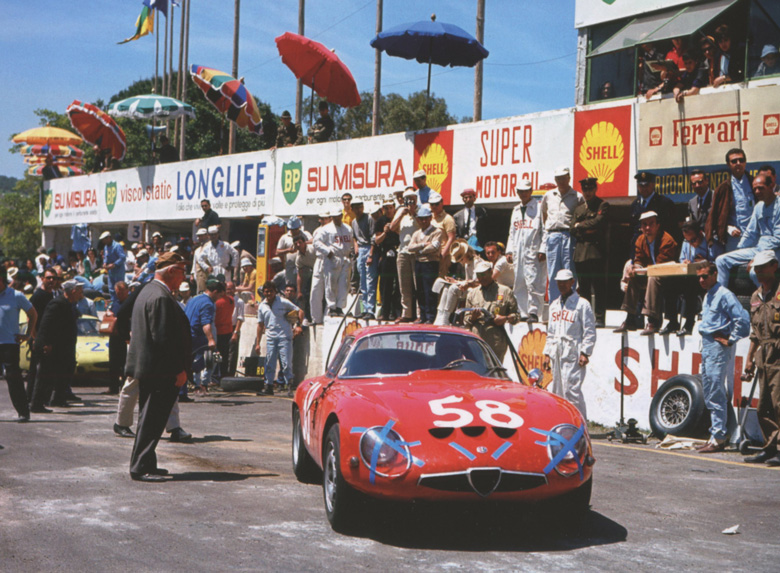
A photo from the 1965 Targa Florio captures all the color and excitement of those last years before everything changed.
Alfa Romeo TZ-TZ2 Born to Win
Author: Vito Witting da Prato
ISBN 978-88-7911-641-1
Language: English
Dimensions: about 24,3 x 27 cm Hardcover, no jacket
Pages: 214 pages
Publisher: Giorgio Nada Editore
Price (approximate) $90
Review by Pete Vack and Graham Earl
All photos from the book
Let’s put it this way: If the editor of VeloceToday was to write, commission, publish or even think about, a book about the Alfa TZ/TZ2, the table of contents might read something like this:
I. Introduction with an emphasis on Alfa activities and politics, 1955-1975.
II. The Creation of the Alfa Romeo TZ. This would include all relevant interviews, recollections, statistics, history, factory diagrams and drawings, restoration notes and complete description of the model. Include a chapter on detailing out one particular chassis.
III. TZ by chassis number. This would present each chassis number and include racing history, ownership history, past and present photos as possible. This would constitute the bulk of the book.
IV. Creating the Alfa TZ2. Similar to section on Creating the TZ.
V. TZ2 by chassis number; race history, ownership, photos similar to TZ.
VI. Special TZs and mysteries
VII. Notes, Bibliography, Index
While the above sounds simple, it is not. Nor has it been done yet, and it probably will never be done as such, given the problems of gathering particular, factual information on over 100 cars scattered around the world. It would also be a huge book, somewhere around 300 pages in length. Costly to be sure, with a limited audience.
So much for the dream book. The reality is less kind. Once upon a time many moons ago Marcello Minerbi put together a fine book on the series, titled Alfa Romeo Zagato SZ e TZ but it was slim; less than 200 pages were devoted to all three Zagatos, the SZ, TZ and TZ2. It did have a comprehensive list of chassis numbers with owners up to 1985 when it was published by La Mille Miglia Editrice. In both English and Italian, definitely a must have for Alfa nuts.
Four years later in 1989, Italian Alfa enthusiast and SZ/TZ owner Vito Witting Da Prato and American Alfa historian Donald Hugues produce an excellent book on the SZs, titled Alfa Romeo Veloce, The Racing Giuliettas, 1956-1963. A super book, with relevant chassis numbers of the Zagato cars and a very complete race and rally history. But it ended as the TZ saga began.

The first version of the TZ had rectangular headlights which didn’t fit the design. According to the book, the new fangled headlights were Busso’s idea.
Now, 28 years later, Da Prato has produced the sequel, Alfa Romeo TZ-TZ2, Born to Win. At last, we thought, this would be the book we’ve been waiting for, as Da Prato is eminently qualified to write the complete history of the TZ, and did such a superb job with Hugues on the SZ history.
And in fact, aside from the comprehensive history of each of the chassis, Da Prato has done a competent job with much new material and interviews with the drivers, designers, and engineers involved with the birth of the TZ.
The first four chapters of Da Prato’s book are certainly interesting but not particularly relevant. The book really begins with Chapter 4, as Da Prato relates how the new Alfa President Giuseppe Luraghi decides to take a tentative step toward the construction of a new Alfa race car. Da Prato then explains the evolution of the disc brake at Alfa, which replaced the effective three leading shoe solution. The TZs were not the first to use them but did so quickly and on all four wheels.
Something new to this reviewer was the discovery, in 1983 at Portello, of the 105 1300 engine originally destined for the 1570cc TZ, complete with special sump, a Hirth roller crank and twin plug head. In the same chapter can be found scanned pages of the TZ Parts Manual and the Operators Manual.
In describing the design development, try as he might, Da Prato can’t come up with a rational reason why Giuseppe Busso wanted the first TZ to be a spider (because he wanted it, that’s about it). It’s failure set the TZ project back by weeks if not months. The chapter entitled AutoDelta Destination Udine relates the inside details of the difficulties of handing off the TZ project to Chiti, who, along with engineer Ludovico Chizzoli, had decided to based his AutoDelta works in Udine, four hours from Milan and at the time seemed like a world away from Portello. The problems encountered while trying to assemble the first TZs are both humorous and yet all too true. An undated interview with Ludovico Chizzola, who wanted Autodelta to remain in Udine (near Venice) is particularly revealing.
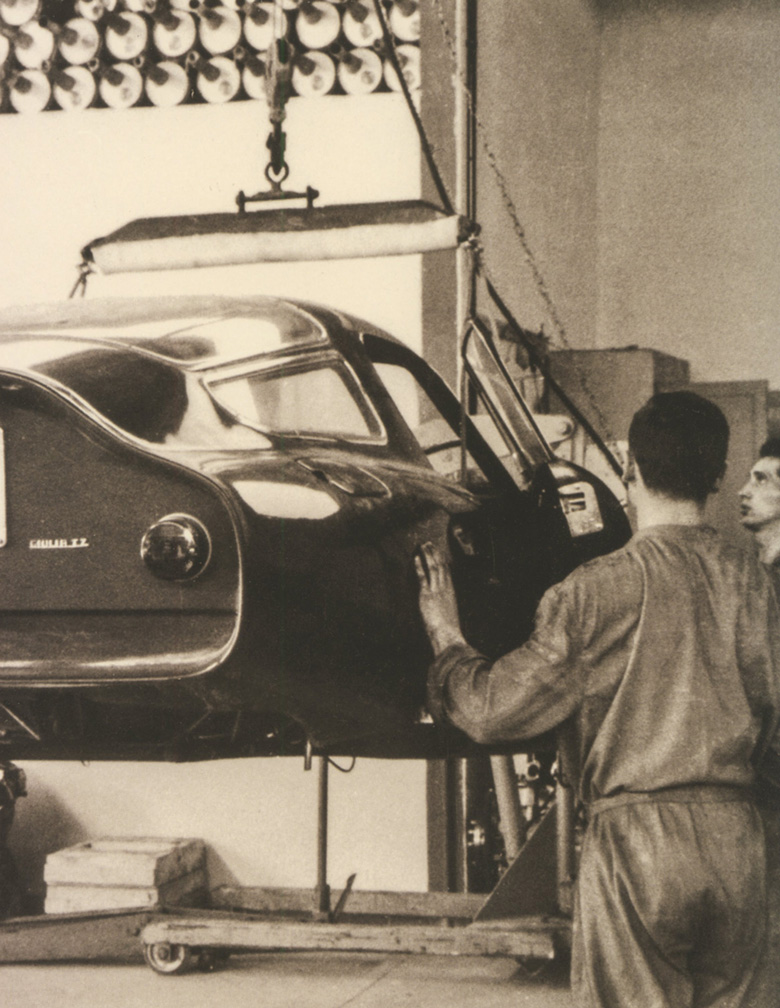
Da Prato found a series of great photographs taken of the TZ assembly at Udine, this is one of the images from the collection.
It is these interviews, some dated as far back as 1984, that bring life to both the book and the subject matter. Interviews include Giuseppe Busso, Chizzola, Ercole Spada, test drivers Guido Moroni and Bruno Bonini and Virgilio Conrero.
The photos are often impressive and there are many full color contemporary racing images that we’ve never seen, but others are all too familiar. The Competition chapters consist mostly of photos with few results. Da Prato gets into a great in-depth description of the TZ2, but the text begs for more detailed photography. In the Appendix, there is a list of chassis numbers, but offers nothing new and only lists the first owners; Minerbi’s list is much more complete and one might even find more up to date information on the Internet. It is sadly lacking an index, footnotes or bibliography.
However. If you love Alfas, you will, you must, buy this book, and yet wait will for the elusive definitive Alfa TZ bible, which may not come in our lifetime. Below, Alfa enthusiast and VeloceToday contributor Graham Earl gives his take on the book. Read it.
Review by Earl Graham
For such a well-loved and collectible car, the TZ, and its later TZ2 development, have had relatively few books published about them. So it was with great anticipation that I opened the latest offering from Vito Witting da Prato. Here is a book solely concentrating on the TZ and nothing else, or so the title would lead one to believe. Da Prato is well-placed to write the story on these magnificent cars, having actively campaigned a TZ when new and restored a TZ2 in later years. His previous credits include the history of the racing Giuliettas, so hopes were high as I began to read.
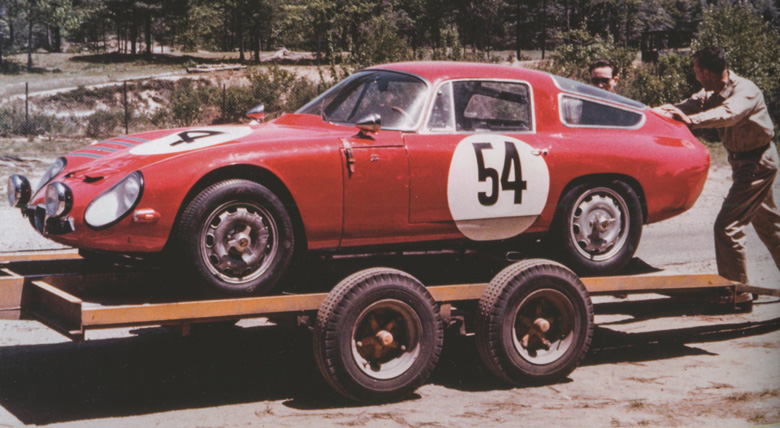
An Alfa TZ, 0051 at Thompson CT. in 1964 when driven by George Fogg. The TZ was not approved for SCCA racing and that limited the sales in the U.S.
The book is not long, at 214 pages, some of which are taken up with lists of production numbers, full page photos, reproduction of documents and the like, and what text there is is not tightly packed, so all in all, the written word is fairly limited. The first 60 pages are devoted to a rather too lengthy history of Alfa Romeo and Autodelta, and whilst this makes interesting, and at times, enlightening, reading, it occupies too much of the available space.
When da Prato does get down to discussing the TZ much of what he writes is from first hand personal experience, and the text is interlaced with interviews with some key figures from the project – from designers to engine tuners, and even Chizzola himself. Whilst this is a nice way to get clear and concise, unambiguous information down on the page, the information is very limited, and some of it is repetitive. There isn’t too much in the way of technical detail, and the reader is often left wondering by statements such as “a modification to the central chassis being the main change to the tubular spaceframe”, when discussing differences between the TZ and TZ2. A fuller explanation as to what that modification was would make the book more valuable. Paradoxically, this brevity of detail is the opposite to da Prato’s almost obsessive references to wheel widths.
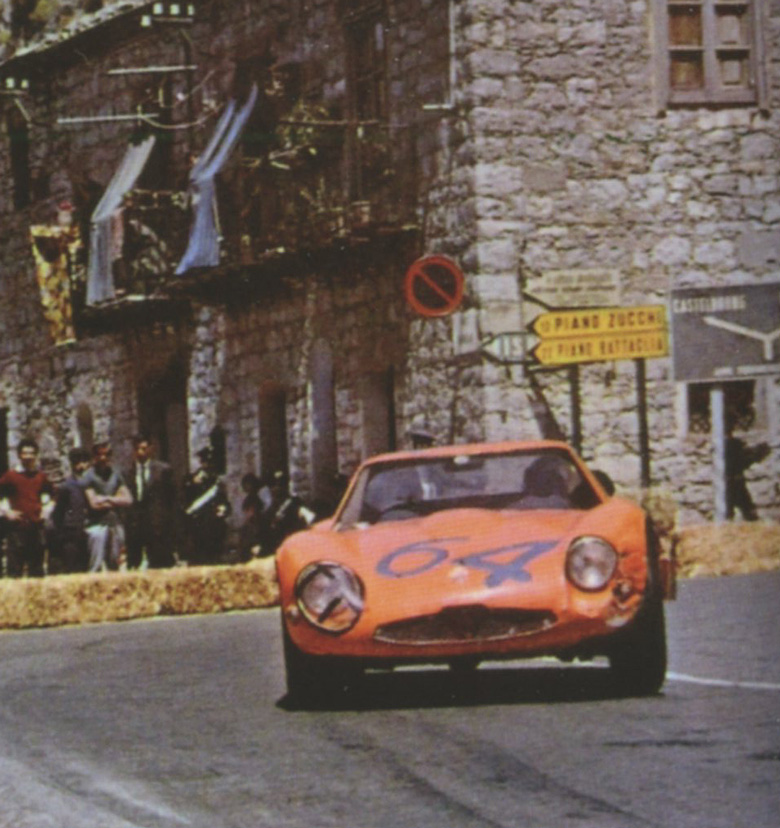
We are all familiar with the photo of the orange TZ2 at the Targa Florio, but da Prato explains why it was painted in such an unusual color.
Usefully, the book quashes a few myths, and manages to straighten out a few confusions about certain cars built during the interim period during the changeover from TZ to TZ2, and for many readers this alone will be worth buying the book for.
There is just one chapter dealing with the TZ2, and that is very brief, and by no means a comprehensive study of the model. All of the photos in that chapter have been lifted from other publications, which is very disappointing, even more so when da Prato talks about a TZ2 he restored. Why no photos of the restoration process, or before and after shots?
At times the text is a little hard to follow, written as though it has been translated from another language, but here I am nit-picking. The editing falls down once or twice as well, with text referring to earlier discussions, which must have been removed from the final draft, and whilst finding fault, there are a few typos, but as I say, this is really nit-picking.
There is a good number of previously unseen (by me, anyway) photos, but too many of the pictures have been seen in previous publications. Also lacking are good detail shots, and a gallery of really decent pictures of a definitive sample car would have been nice, and something I would have expected to see.
For anybody new to the subject, who doesn’t have either of the previously published books on the TZ there is sufficient information to render this an essential purchase, but there are rather a lot of gaps and unanswered questions. My feeling is that there is still room for a definitive history of these cars, which this book falls a little short of being.
Buy the book anyway – it’s certainly worth having.
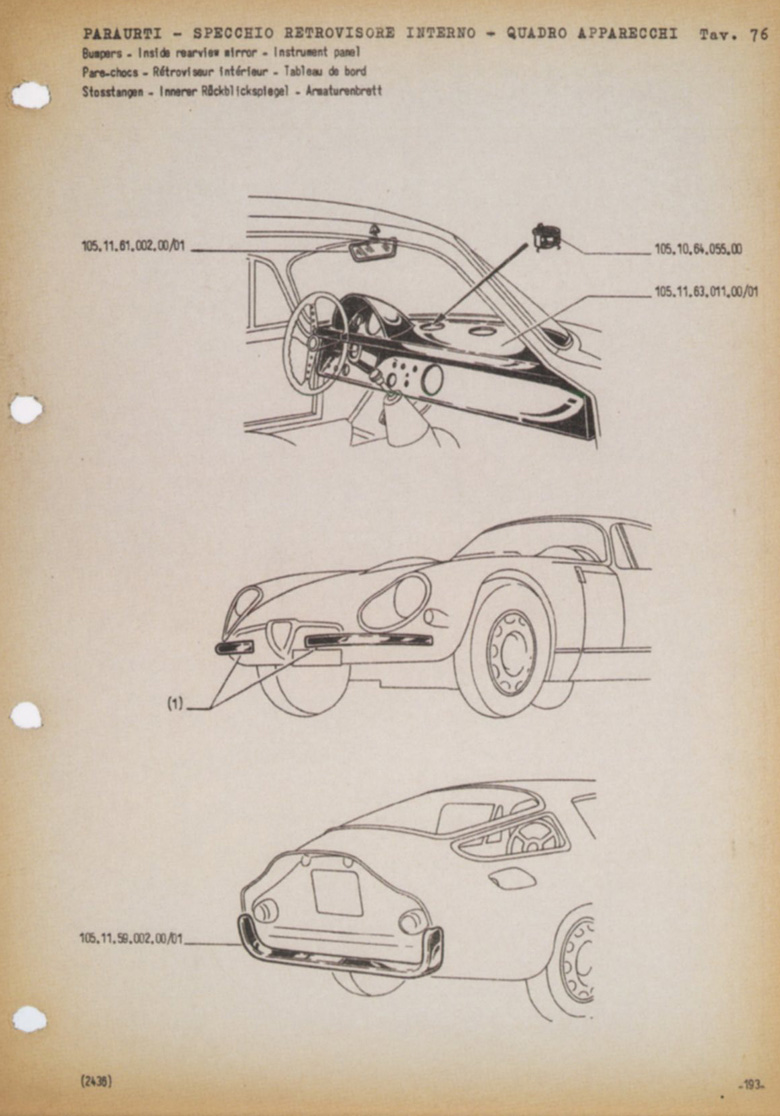
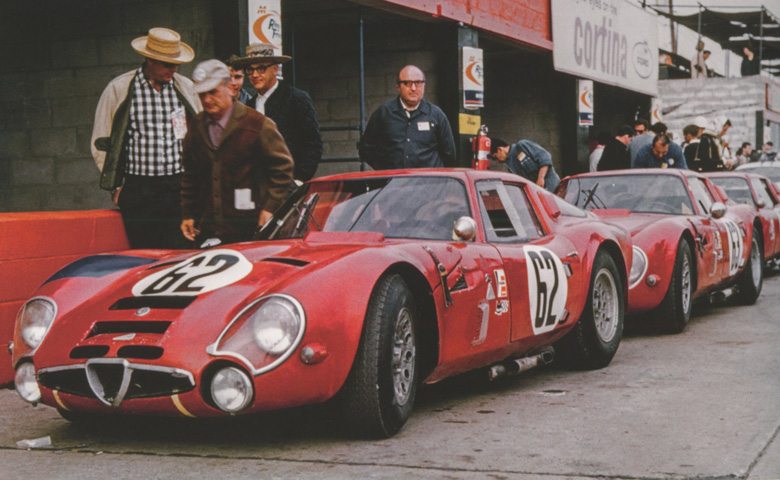
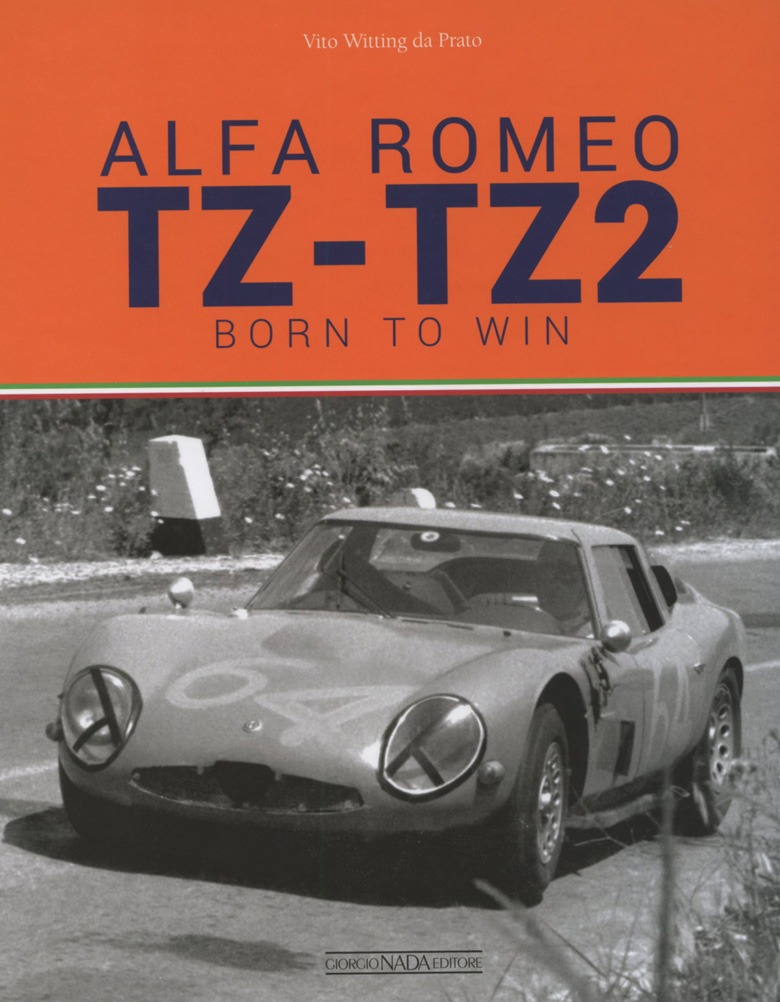
This is a fine book about these racings cars yet nothing is perfect in life.The races in which these cars raced are hardly covered in any detail.The book takes a good look at the development thought and beginning of Autodelta.Still very welcome indeed.
the car could’ve run scca as an f-modified. only production classes had to be approved by the scca; mods were by displacement.
Particularly my first difficulty, brought this response from the author
Reading your comments was very very interesting and appreciated. It is no coincidence that I shared these same “negative” opinions with the editor before the book went into print: a) size of character, and b) especially weak contrast for captions, were two objections I made. In fact I had also pointed out to him that probably a considerable number of readers were no longer teenagers! But, you know, others know better…!
However, especially as I am not TZ knowledgeable, I found it fascinating enough to be frustrated by two or three photos in a different place, thus needing to return to try and find the reference again, It would have clarified or raised questions more easily.
The 8? items for a comprehensive TZ book (whatever happened to item III?)
Taking item IV and VI, da Prato is not a registrar and thus not the object of the book. Minerbi, took Don Hughes’ SZ list without giving him credit (hopefully not knowing that it was Don’s source that he was using).
Part of item II in this day and age is dangerous. Simon Moore succeeds in apparently giving a complete description of a 2.3 or 2.9 without having to give enough details for fakers. It is difficult enough to keep ahead of them for the Zagato 1900, but Zs and TZs must present an even greater problem. Thank goodness da Prato has resisted from that.
Item VIII. Yes, an index can be useful, but I have not a clue how one could list a useful one. In Colin Crabbe’s recent book, he made not only an index but by no less that 6 different ways. I happened to want to refer to one car, and it was not in any of them! (doubtless not worthy!).
I am not sure that a bibliography would not have served any further purpose than the credits.
I did not know anything about a roller bearing crank engine but coincidently this week I was reading about another identical 105 1300 engine, in England.
Relevant interviews ~ I agree, you couldn’t ask for more. I learnt much.
Peter